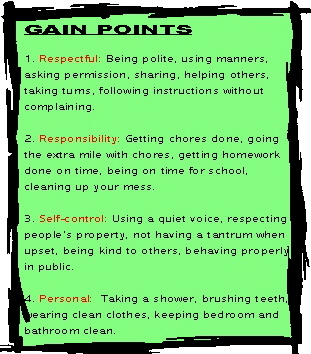Experts are suggesting that parents of children with ADHD and other behavioral difficulties should try using a point (or credit) system for discipline and motivation. In a recent PEOPLE magazine article, I read about a special camp for children with ADHD run by Dr. Karen Fleiss. The camp gives points for good behaviors, and takes them away for less appropriate ones. Campers who achieve a certain number of points during the week are rewarded with a special Friday field trip. In the article, Dr. Fleiss says that the point system helps motivate these kids to choose the right behavior.
With a point system, the parent is no longer the “bad guy,” arbitrarily making threats or giving punishments. Instead, the child learns that if he misses out on a particular privilege, there’s nobody to blame but himself. As point totals grow or shrink, the child is able to see the number of privileges increase or decrease. Thus, there is more personal accountability for behavior and fewer power struggles.
But a point system seems so complicated!
It doesn’t have to be. Here’s how to get your program started. You’re going to create three lists. The first is a “Lose Points” list. You’ll want to create a thorough list of every problem behavior you’ve dealt with, and even some you haven’t. (With these lists, be specific without being overly exhaustive. Try to use terms that will cover a lot of possibilities.) Here’s an example:

Your next list will be all the behaviors you’d like to encourage, called a “Gain Points” list. Here’s an example:

Next, you’ll want to determine a point value (or negative point value) for each category of behaviors. For example, violent actions could be negative ten (-10) and less serious infractions could be negative five (-5). Positive behaviors should be given points depending on how much effort is shown. Personally, I would not set a point value for every single behavior, but one per grouping.
Last, you will create a list of rewards for points earned. To make the point system work, you’ll want to list every single perk the child has, (besides vital things like eating) and give each one a point value. You won’t need to create a list of penalties, because the child is automatically penalized when his points don’t add up to the perks he wants. For example, if your child doesn’t have enough points to watch television, he’s restricted from TV without you “declaring” it.
Set point values higher for bigger rewards, like going to a movie, and lower for daily perks like television viewing. Ask yourself…how many times would I like to see good behaviors in a day? That total could be a “television viewing” value. How many good behaviors in a week? That total could earn a trip to the movies. Allow for a couple mess-ups. Base the values on what is most motivating for your child. It’s likely you’ll have to adjust values somewhat as you test out your system.
You may want to laminate your lists without point values, and then use a dry-erase marker to indicate the numerical values and keep track of totals. This will make adjustments easier. Your child will then get to “buy” daily rewards and save up for larger ones.

Before implementing your program, you’ll need to sit down and carefully discuss it with your son or daughter. It might help to compare the point system to a video game. Explain that the child will gain or lose points based on what she chooses. Provide your son or daughter with a notebook to keep track of points earned. You should explain that PARENTS have the ultimate authority to give or remove points, and points cannot be asked or begged for. Also, parents need not follow the child around, giving points for every single action. Only the behaviors that stand out need receive (or lose) points. But remember that good behaviors are less noticeable, so pay closer attention to those.
Be prepared for your child to “test” your resolve and try to thwart your plan. Stick to it and remember that you have absolute power to give “extra credit” points when needed or adjust numbers. The system works best when your child is very involved in seeing his point totals and recognizes the pay-off for good behaviors. Start each new week back at ZERO.
Will this work on a younger child?
You’ll need to simplify your lists to very basic two-word rules, like “no hitting.” You may want to use icons or pictures for children who don’t read. You could use stickers in place of numbers, or smiley faces velcroed to a strip so the child can see the numbers increasing or decreasing.
Kristyn Crow is the author of this blog. Visit her website by clicking here. Some links on this blog may have been generated by outside sources are not necessarily endorsed by Kristyn Crow.

